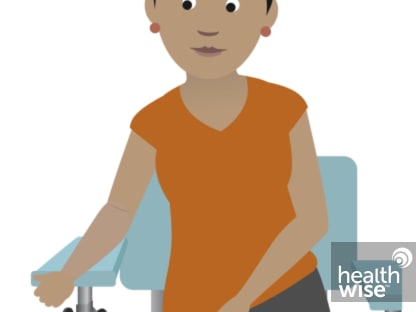D-Xylose Absorption Test
Test Overview
The D-xylose absorption test measures the level of D-xylose, a type of sugar, in a blood or urine sample. This test is done to help diagnose problems that prevent the small intestine from absorbing nutrients in food.
D-xylose is normally easily absorbed by the intestines. When problems with absorption occur, D-xylose is not absorbed by the intestines, and its level in blood and urine is low.
Why It Is Done
A test for D-xylose is done to:
- Check to see if malabsorption syndrome is causing symptoms, such as chronic diarrhea, weight loss, and weakness. A person with malabsorption syndrome is unable to absorb nutrients, vitamins, and minerals from the intestinal tract into the bloodstream.
- Find the cause of a child's failure to gain weight, especially when the child seems to be eating enough food.
How To Prepare
For 24 hours before a D-xylose test, do not eat foods high in pentose, a sugar similar to D-xylose. These foods include fruits, jams, jellies, and pastries.
Medicines such as aspirin and indomethacin can interfere with the results of a D-xylose test. For this reason, your doctor may instruct you to temporarily stop these medicines before the test.
Do not eat or drink anything except water for 8 to 12 hours before having this test. Follow the doctor's instructions about how long your child needs to avoid eating and drinking before the test.
A D-xylose test can take a long time. It might be a good idea to bring something you can do quietly while you wait, such as a book to read.
How It Is Done
The amount of D-xylose in urine and blood samples is measured before and after you drink a D-xylose solution. To begin the test, a sample of your urine and a sample of your blood may be collected.
Next you will drink a D-xylose solution. For adults, a blood sample is usually taken 2 hours after they drink the solution. For children, a blood sample may be taken 1 hour after they drink the solution. More blood samples may be drawn during the test.
You will need to collect all of the urine you produce for 5 hours after you drink the sugar solution. You will be told to rest or lie down during the test. And you won't be able to eat until the test is completed.
Watch
How It Feels
Blood test
When a blood sample is taken, you may feel nothing at all from the needle. Or you might feel a quick sting or pinch.
Urine test
There is no pain while collecting a 5-hour urine sample.
Risks
There is very little chance of having a problem from this test. When a blood sample is taken, a small bruise may form at the site.
Results
Normal
Each lab has a different range for what's normal. Your lab report should show the range that your lab uses for each test. The normal range is just a guide. Your doctor will also look at your results based on your age, health, and other factors. A value that isn't in the normal range may still be normal for you.
Low values
Low values may be caused by:
- A disease that interferes with the intestine's ability to absorb nutrients (malabsorption syndrome), such as celiac disease, Crohn's disease, or Whipple's disease.
- Inflammation of the lining of the intestine.
- Short bowel syndrome.
- An infection with a parasite, such as giardiasis or hookworm.
- An infection that causes vomiting (such as food poisoning or the flu).
Related Information
Credits
Current as of: September 25, 2025
Author: Ignite Healthwise, LLC Staff
Clinical Review Board
All Ignite Healthwise, LLC education is reviewed by a team that includes physicians, nurses, advanced practitioners, registered dieticians, and other healthcare professionals.
Current as of: September 25, 2025
Author: Ignite Healthwise, LLC Staff
Clinical Review Board
All Ignite Healthwise, LLC education is reviewed by a team that includes physicians, nurses, advanced practitioners, registered dieticians, and other healthcare professionals.




